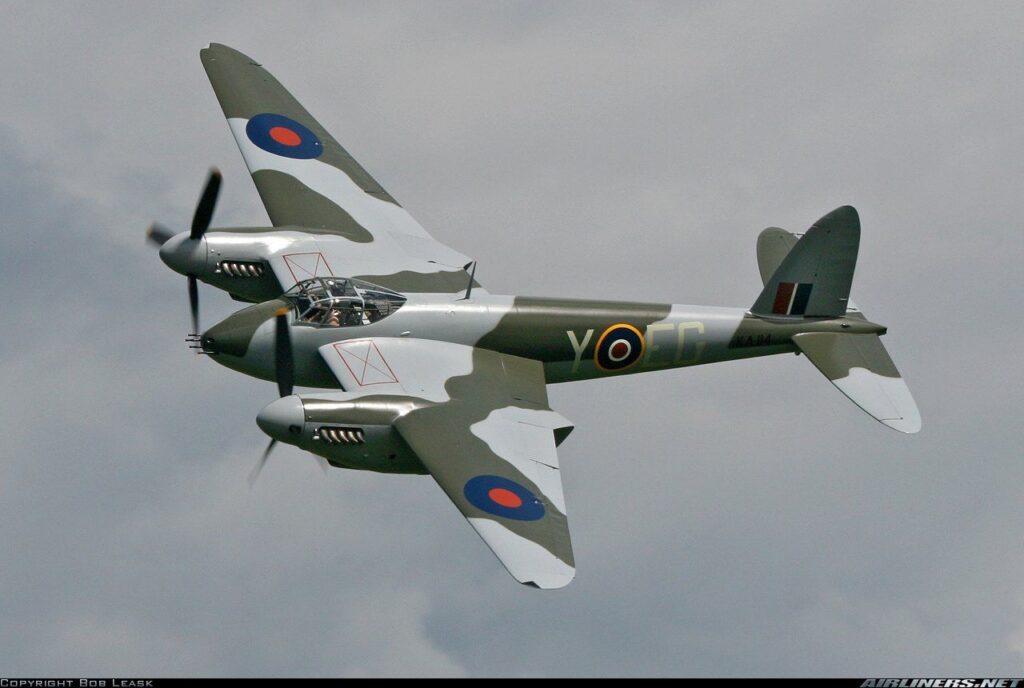
We think of the idea of a wooden plane as somehow backward looking – stick and string WW1 types – but in fact laminated plywood was a new and rather fantastic ‘composite’ material. Today most warplanes use composites, carbon fibre plastics, instead of aluminium.

It was a lightweight solution to the power-to-weight conundrum that makes great designs into winners. Using plywood solved a lot of problems, and was not only a way to save on aluminium. In that sense the Mosquito was a forward looking aircraft.
The only drawback was that better glues had to be developed to allow the Mosquito to serve in the hot and humid climate in Burma, but that problem was solved too.
The Mosquito’s aerodynamic efficiency, small size relative to other aircraft of similar power, superlative Rolls Royce Merlin engines and excellent power-to-weight ratio gave it many advantages:
- Lightness and power meant it could carry plenty of fuel and a large payload. Bomber versions were soon adapted to carry a 4,000 pound ‘cookie’ bomb, giving it a better bomb-load than a much larger B-25 or B-26, with greater range and much better performance. Mosquito bombers could range across Germany accompanying heavy bombers as pathfinders, or conducting precision raids on their own. They didn’t require a large crew or defensive armament as they could fly faster and higher than pretty much anything put up against them.
- The Mossie had excellent high altitude performance – which along with a large fuel capacity and high speed made it ideal as a high performance strategic reconnaissance platform, with little adaptation. A role it continued to perform well into the 1950s.
- De Havilland’s fighter-like design made the Mosquito highly manoeuvrable – more akin to a single seater than a multi-engined bomber. When used in the night fighter and fighter-bomber role it could carry a very heavy armament over long ranges with little impact on performance. Fighter-bombers could carry 1,000 pounds of bombs internally and another 1,000 pounds, or eight 60 pound rockets, externally, plus extra fuel tanks and a gun armament of 4x20mm cannon and 4x rifle calibre machine guns, all concentrated in the nose. Unlike most fighter-bombers it had the same range fully loaded as P-51 or B-17 and could be used as long-range interdictors.
- One version was fitted with a 57mm anti-tank gun with an autoloader in the bomb bay to attack shipping. Fighter-bombers were used for precision raids on high value targets, to interdict lines of communications, attack airfields and V1 and V2 sites, and in an anti-shipping strike role.
- Mosquito night fighters were progressively fitted with more sophisticated radars, and had the range to provide escorts for long range night bombers over Germany, or to carry our interdiction attacks on night fighters at their bases while the attempted to take off or land to intercept RAF bomber streams. They outperformed every German night-fighter except the Heinkel 219 Uhu, which was produced in very small numbers, was not as quick and did not have the range or altitude performance of a Mosquito.
- A few Mosquitos were adapted as unarmed high speed civilian transports and given to BOAC to operate a service to Sweden so that Britain could purchase rare metals and some specialised equipment from the neutral nation. They flew with impunity through the German air defences in Norway and Denmark (although passengers had an uncomfortable ride as they had to lie prone in the bomb bay!).
- The Mosquito’s heavy payload, range and altitude performance meant that it could also be used as an electronic warfare platform, and it was used in that role by 100 group, flying high above the heavy bomber streams with a suite of radar and communications jamming equipment and a bomb load of chaff.
- As someone mentioned, the Mosquito’s small size and weight also made it a candidate as a carrier borne bomber, and a Sea Mosquito torpedo bomber was developed for service in the pacific, only too late to see service in WW2 (a small number saw service post war).
Mosquitos were loved by their crews and manufactured in Australia and Canada as well as in the UK, and also served with the USAAF as a photo recce type. Mosquitos continued to serve well into the 1960s as high speed target tugs.
In many ways the Mosquito was a precursor of the two-seat twin engined high performance fast jet fighter-bombers that replaced ‘medium bombers’ as the standard interdictors in most air forces from the 1960s. It was closer in design philosophy and comparative performance (i.e compared to the air superiority fighters of its day) to a Panavia Tornado or a F–111 Aardvark than to the medium bombers of WW2. In that sense it was revolutionary.
So yes it was indeed one of the best aircraft designs to be mass produced of the period, and gave the allies an extremely versatile platform which required little adaptation to fulfil a range of critical roles superbly.